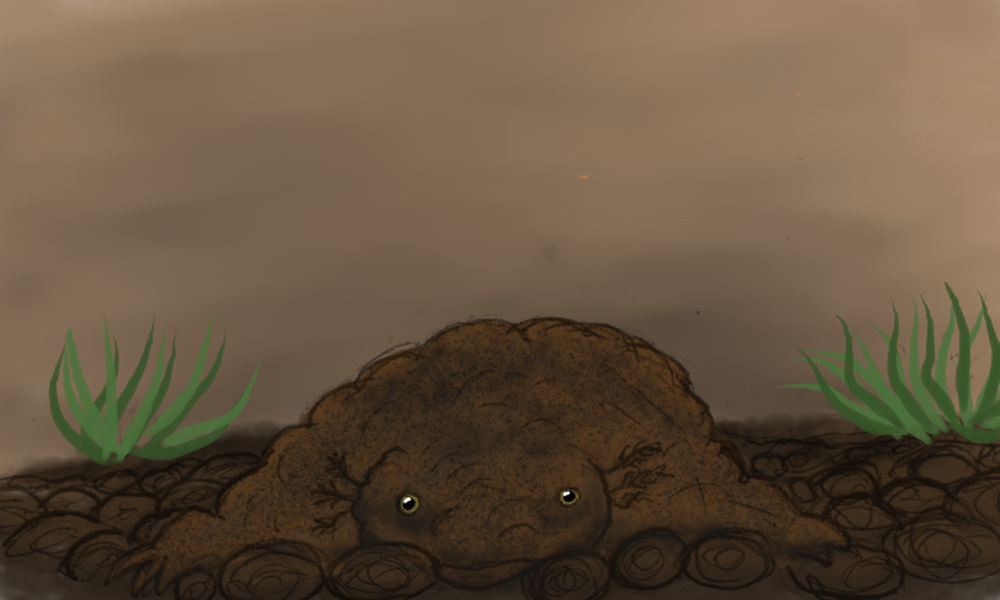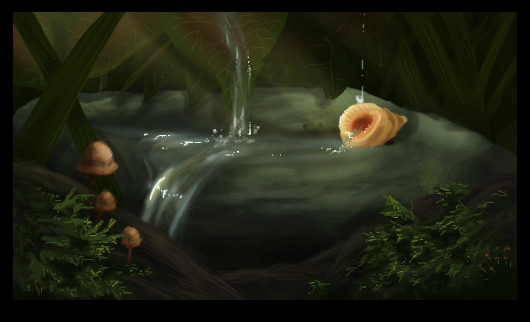HOME | DD
 Dragonthunders — The rocky lumpy-mander
Dragonthunders — The rocky lumpy-mander

Published: 2016-02-26 17:57:41 +0000 UTC; Views: 1952; Favourites: 41; Downloads: 2
Redirect to original
Description
(Lithocutaneus hydrotelus)
With just 20 cm in length is an endemic inhabitant of rivers and pools of rocky soil on Telu.
It belongs to a group known as "Limodermata" (mud skin) formed about 5 species, which are a type of neotenous amphibians which inhabit the bottoms of rivers and lake, hidden in the mud and are commonly detritus, however, the rocky lumpy-mander has found a more efficient way to hide without having to hide under the mud.
Its body is plump and bulky in an oval-shaped, with a long tail shovel-shaped. Their legs are short and muscular with 4 fingers without claws on each. The head is almost triangular with a small flat jaw filled with a row of teeth on the front; on the back / side of the head, three pairs of small external gills arise.
It feeds mainly on invertebrates can be found, crustaceans, worms, minnows and others. Its main feature is its ability to blend in with the background of its habitat. This has been possible because it has taken the color and texture of the surrounding environment, developing a range of dark brown and gray colors.
To bind to soil, lumpy-mander makes a small trench where they settle and arrange the rocks found in around so that goes unnoticed by any predator.
If disturbed or attacked, this can be driven with its thick limbs and muscular tail, swimming in circles and so, raising all matter around dirt generating a screen that confuses the predator and gives time to escape. This type of behavior is not entirely uncommon, as several similar species have also shown this same type of defense.
They are much more active at night; usually they go immobile during the day. Its appearance was probably recent, approximately during the Paleogene when the third wave of migration occurred towards the island that brought new varieties of animals, and therefore predators. They reproduce sexually way, through external fertilization; female accommodates their eggs in a nest, while the male fertilizes them. Then the female covers the fertilized eggs and they take a few days until the larvae hatch. Hence, they have a life expectancy of about 15 to 20 years.
It is quite strange to find, and when it is done, it should be quite cautious because this can make its r disappearing act; this however is considered a waste of time, because even if someone is able to find it, should leave it free, because it is difficult to breed outside their habitat.
**********************************************
Part of a community project known as Bigone World
-------------------------------------------------------------------------------------------
Con apenas 20 cm de longitud es un habitante endémico de los ríos y charcos de suelo rocosos de Telu.
Pertenece a un grupo conocido como “Limodermata” (piel de lodo) conformados alrededor de 5 especies, que son un tipo de anfibios neotenicos los cuales habitan los fondos de los ríos y lago, escondidos entre el fango y son comúnmente detritívoros, sin embargo, el rocky lumpy-mander ha encontrado una forma más eficiente para esconderse sin tener que ocultarse bajo el fango.
Su cuerpo es rechoncho y abultado en forma oval, con una cola larga en forma de pala. Sus patas son cortas y musculosas con 4 dedos sin garras, en cada una. Su cabeza es casi triangular con una mandíbula llena de una fila pequeñas de dientes en la parte frontal; en la parte posterior/lateral de la cabeza, surgen tres pequeños pares de agallas externas.
Se alimenta principalmente de los invertebrados que pueden encontrar, crustáceos, gusanos, pequeños peces y otros. Su principal característica es su capacidad de camuflarse con el fondo de su hábitat. Esto ha sido posible debido a que ha adoptando el color y la textura del ambiente alrededor, desarrollando un espectro de colores marrones oscuros y grisáceos.
Para fijarse al suelo, el lumpy-mander hacen una pequeña zanja donde se asientan y arreglan las rocas que se encuentran en su alrededor de tal modo que pasa desapercibido ante cualquier depredador.
Si es perturbado o atacado, este puede impulsarse con sus gruesas extremidades y su musculosa cola, nadando en círculos y así, levantando toda la materia a su alrededor generando una pantalla de suciedad que confunde a su depredador y le da tiempo para escapar.
Este tipo de comportamiento no es totalmente raro, ya que varias especies semejantes también han mostrado este mismo tipo de defensa.
Son mucho más activos durante la noche, normalmente pasan inmóviles durante el día. Su aparición fue probablemente reciente, aproximadamente durante el paleógeno cuando ocurrió la tercera ola de migración hacia la isla que trajo nuevas variedades de animales, y por ende, depredadores. Se reproducen de manera sexual, por medio de la fertilización externa; la hembra acomoda sus huevos en un nido, mientras que el macho los fertiliza. Posteriormente la hembra cubre los huevos fertilizados y estos tardan un par de días hasta que las larvas salen. De ahí, estos tienen una expectativa de vida de alrededor de 15 a 20 años.
Es bastante extraño encontrarlo, y cuando se hace, se debe tener bastante cautela ya que este puede hacer su acto de desaparición; esto sin embargo se considera una pérdida de tiempo, ya que aun si alguna persona es capaz de encontrarlo, se recomienda dejarlo libre, ya que es difícil de criar fuera de su hábitat.
Parte de un proyecto comunitario conocido como "Bigone world"
































